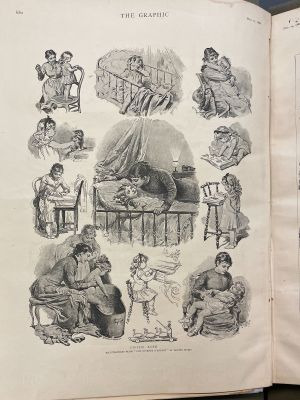The Graphic: a Premier Illustrated Newspaper
This item is a collection of The Graphic’s weekly illustrated newspapers dating from July to December 1891. The weekly newspapers are bound together to create a large book, and to likely be stored as a volume. This copy of The graphic is located on the sixth floor of the University of Pennsylvania’s Van Pelt Library in the Kislak Center.
Background
The Graphic was a weekly illustrated newspaper launched in London in 1869 by William Luson Thomas and his brother Lewis Samuel Thomas. Upon its launch, it became quite successful; it was a common rival newspaper for the Illustrated London News, which was founded in 1842, 27 years earlier and was the first weekly illustrated newspaper in the world.[1]
Content
Each weekly issue of The Graphic contains 24 pages of folio with several illustrations embedded throughout.

The Graphic covered news from around the Empire and covered a wide range of topics which included arts, sciences, fashion, sport, music and more. Each issue typically began with “Topics of the Week” – which was 12 paragraphs of news coverage – and included a variety of other sections like “Our Illustrations” (a summary of all the illustrations in the edition), “Home” (summary of the British news), “Church News”, “Legal” (trials and cases of interest), “Book Reviews,” “New Music” (reviews of the latest music and musicals), “Obituaries” of notable people, “Sport” which included coverage of sports like football and cricket
Materials
The Graphic is full of high-quality wood engraving prints, which were all done with great detail and by talented artists like Henry William Brewer, a notable illustrator who was considered to be one of the greatest architecture draftsmen of his time. The large size of the pages indicates a desire by the artists to display its impressive illustrations. The cover of this particular book is decorated with paper marbling, a popular decorative choice for the cover and inside covers of books in the nineteenth century. This particular copy of the Graphic did not have any readership. The pages are in perfect condition, with no annotations or damage to them. This copy was likely created as a volume to store in the archives of the newspaper, and was not created to be circulated.
Woodblock Printing
These illustrations are made by the woodblock printing process, the oldest form of printmaking where the desired image is carved into the surface of a wooden block and the book is submerged in ink and pressed onto paper to create the image. In this process, the carved areas of the block do not fill with ink and, thus, do not leave any impression on the paper. The woodblock printing process is a form of relief printing, where the process of cutting or etching the wooden printing surface in such a way that all that remains of the original surface is the design to be printed. In this particular book, the images are crisp and well made, clearly by talented artists. Almost all of the illustrations remain intact and clearly visible.
Historical Significance
Franco-Prussian War
The Franco-Prussian War began in July of 1870, when Prussia – a coalition of German states at the time – defeated France. The paper printed its first illustration of the war on 13 August 1870 with – less than a year after its establishment – and instantaneously became highly circulated:
“The outbreak of the Franco-Prussian War gave the paper its opportunity. The circulation rose by leaps and bounds, and success – a unique success – was assured.” [2] The Graphic's coverage of the war was outstanding and immediately placed them as a threatening competitor to the Illustrated London News.Cite error: Closing </ref> missing for <ref> tag
This newspaper circulated in London and was geared towards a wealthier audience because it was reportedly more expensive than all of the rival newspapers of the time. It contained 24 pages and was sold for sixpence, the most expensive of all of the weekly illustrative newspapers. It was not available to modest-income classes, but it became extremely popular amongst wealthier classes.
It was the rival newspaper for the more popular London Illustrated, but it appears the Graphic would have had a smaller, more niche audience than the mainstream graphic. It had a reputable art stance, with even artists like Vincent Van Gogh as a major fan and avid collector.[3]
References
- ↑ Hampson, Robert. “Conrad and the ‘Illustrated London News.’” Conradiana 41, no. 1 (2009): 67–87. http://www.jstor.org/stable/24635193.
- ↑ C.N. Williamson. "Illustrated Journalism in England: Its Development. -- III." Magazine of Art. 1890. 391-96.
- ↑ Ebbatson, Roger. “TESS’S BOOTS: HARDY AND VAN GOGH.” The Thomas Hardy Journal 30 (2014): 54–65.